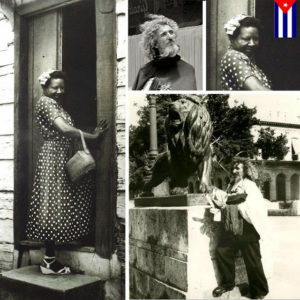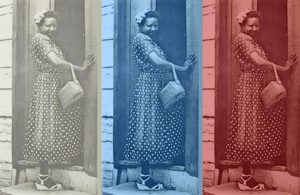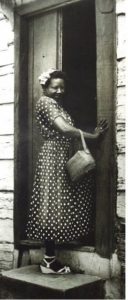 PERSONAJES DE MI VIEJA HABANA: LA SINGULAR “MARQUESA” CUBANA.
PERSONAJES DE MI VIEJA HABANA: LA SINGULAR “MARQUESA” CUBANA.
Al igual que el famoso Caballero de Paris habanero, este personaje de nuestra vieja capital se paseaba por el Parque Central de la Habana donde atraia a los curiosos y turistas con picardia, humor y cuentos de doble sentido.
Esta Marquesa no llevó en sus venas ni una gota de sangre azul, pero fue más “real” que muchas altezas reales. Su nombre verdadero era Isabel Veitia, pero ella prefería que la llamaran Marquesa.
Por un billetico se dejaba fotografiar, no sin antes identificarse como La Marquesa.
Persona de poca estatura, de tez negra, que vestía con suma extravagancia para llamar la atención.
Usaba un pequeño sombrero con un velito de tul que cubría parte de su cara. Se engalanaba con aretes, anillos, brazaletes y collares de fantasía barata . Colgaba de sus brazos una carterita negra de charol y calzaba unos brillantes zapatos de color dorado.
Su ritual de todos los días comenzaba por las oficinas de Godoy-Zayán, el de los seguros y banca, donde le daban dinero en efectivo para que trajera para todos los empleados el café con leche y el pan con mantequilla.
Con el tiempo comenzó a frecuentar los aires libres del Prado, frente al Capitolio, el café Inglaterra y otros lugares al que acudían personas de mayor fortuna y allí la Marquesa no pedía “peseticas” sino billetes porque el sonar de las monedas hería sus delicados oídos.
En la noche, proseguía repartiendo saludos por las mesas de varios restaurantes como el Carmelo de la calle Calzada, El Jardín, y El Potin, donde cerraba su exitoso periplo.
Sólo una broma tonta de mal gusto, sazonada con la proverbial picardía que ella desparramaba, hacía reír a los desprevenidos caminantes, mientras ella abría la bolsa y decía con gracia, “¡Billetes, sólo billetes. Yo soy una Marquesa! Mi condición no me permite aceptar monedas”, decía con gracia Isabel Veitía.
.. Al parecer, Isabel Veitía cae víctima de la demencia cuando arriba a la madurez y se dedica a pedir limosnas hasta mucho después de 1959, que según ella, eran obligadas, porque “los pueblos donde hay reyes le pagan a la nobleza una pensión”.
La Marquesa aseguraba a sus amigos que sus parientes, por parte de madre, fueron reyes en África antes de ser esclavizados en Cuba, y que su padre, del tamaño de un poste eléctrico, y con el sabor de la raspadura, había vivido en Francia como sirviente de una familia aristocrática criolla.
En realidad, esta mujer, llena de “alcurnia y abolengo” y con un lenguaje “afrancesado”, nació en la calle San Salvador número 8, perteneciente al actual municipio capitalino del Cerro, y más tarde, se radicó en San José, en una vivienda bastante huérfana de lujos y comodidades y con un vecindario alejado del París de sus calenturas cerebrales.
Cuentan que de niña la pusieron a trabajar en una fábrica de fósforos, donde le incendió el moño a una compañera de trabajo, y luego, le prendió fuego a un diminuto depósito de petróleo y provocó unas carreras similares a las de Napoleón en Waterloo.
Sobre sus ocupaciones posteriores hay dos versiones: Derubín Jácome atestiguó en la página digital Cuba en la Memoria que ella fue la insustituible repostera de la señora María Luisa Gómez-Mena, Condesa de Revilla de Camargo, a quien nunca le preocuparon sus ojos desamparados y modales cortesanos. Sin embargo, La Marquesa juró más de una vez en público haber sido durante años la doméstica de una encopetada dama francesa, esposa de un diplomático con residencia en La Habana.
Derubín Jácome asevera que en su vejez La Marquesa se hizo cargo de su esposo, inválido y el hijo enfermo. En consecuencia, explotaba en pataleos y chillidos cuando los funcionarios del Estado le ofrecían los beneficios del asilo.
La Marquesa siempre vivió en un paraíso imaginario de emociones, anécdotas, frases y símbolos…
 CHARACTERS OF MY OLD HAVANA: THE SINGULAR CUBAN “MARQUESA”.
CHARACTERS OF MY OLD HAVANA: THE SINGULAR CUBAN “MARQUESA”.
Like the famous Havana Knight of Paris, this character from our old capital was strolling through the Central Park of Havana where she attracted the curious and tourists with mischief, humor and two-way stories.
This Marquise did not carry in her veins a drop of blue blood but was more “real” than many royal highnesses. Her real name was Isabel Veitia, but she preferred to be called Marquesa.
For a billetico, she let himself be photographed, but not before identifying himself as La Marquesa.
Person of short stature, black complexion, who dressed with utmost extravagance to get attention.
She wore a small hat with a tulle hair that covered part of her face. It was adorned with earrings, rings, bracelets and necklaces of cheap fantasy. She hung a black patent leather purse from his arms and shined bright golden shoes.
Her daily ritual began at the offices of Godoy-Zayán, that of insurance and banking, where she was given cash to bring coffee for milk and bread with butter for all employees.
Over time she began to frequent the free airs of the Prado, in front of the Capitol, the England coffee and other places where people of greater fortune went and there the Marquise did not ask for “peseticas” but tickets because the sound of the coins hurt her delicate ears.
In the evening, she continued handing out greetings at the tables of several restaurants such as Carmelo on Calle Calzada, El Jardín, and El Potin, where she closed his successful journey.
Only a silly joke in bad taste, seasoned with the proverbial mischief she spilled, made the unsuspecting walkers laugh, as she opened the bag and said gracefully, “Tickets, only tickets. I am a Marquise! My condition does not allow me to accept coins, ”Isabel Veitía said gracefully.
.. It seems that Isabel Veitía falls victim to dementia when she reaches maturity and dedicates herself to asking for alms until long after 1959, which she says were forced, because “the towns where there are kings pay the nobility a pension ”
The Marquise assured her friends that her relatives, on her mother’s side, were kings in Africa before being enslaved in Cuba and that her father, the size of an electric pole, and with the taste of scraping, had lived in France as a servant of a Creole aristocratic family.
In fact, this woman, full of “ancestry and ancestry” and with a “French” language, was born on San Salvador street number 8, belonging to the current capital city of Cerro, and later, she settled in San José, in a quite an orphan house of luxuries and comforts and with a neighborhood far from Paris from its brain fever.
They say that as a child they put her to work in a match factory, where she burned a coworker’s bun, and then set a tiny oil tank on fire and caused similar careers to Napoleon’s in Waterloo.
On her later occupations, there are two versions: Derubín Jácome testified on the Cuba digital page in the Report that she was the irreplaceable pastry chef of Mrs. María Luisa Gómez-Mena, Countess of Revilla de Camargo, who never worried about her helpless eyes and manners courtiers, However, La Marquesa swore more than once in public to have been for years the maid of a spiked French lady, wife of a diplomat residing in Havana.
Derubín Jácome asserts that in her old age La Marquesa took care of her husband, invalid and the sick son. Consequently, she exploded in kicks and squeals when state officials offered her the benefits of asylum.
The Marquise always lived in an imaginary paradise of emotions, anecdotes, phrases, and symbols …
Agencies/ Wiki/ RHC/ Maria Calvo/ Extractos/ Excerpts/ Internet Photos/ Arnoldo Varona/ www.TheCubanHistory.com
THE CUBAN HISTORY, HOLLYWOOD.









